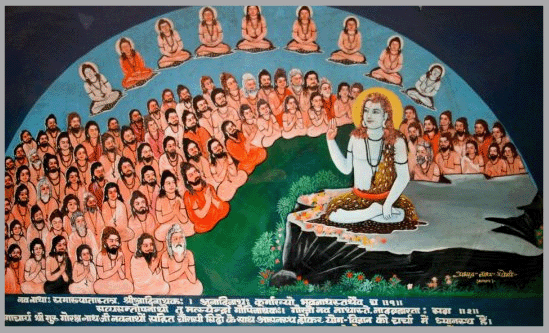What is Nath Sampradaya?
The Sanskrit word Nath is the proper name of a siddha sampradaya (initiatory tradition) and the word itself literally means Lord, Protector, or Refuge. The related Sanskrit term Adi-Nath means first or original Lord, and is therefore a synonym for Shiva, Mahadeva, or Maheshvara, and beyond these mental concepts, the Supreme Absolute Reality as the originator of all things.

The Nath tradition is a heterodox siddha tradition containing many sub-sects. It was founded by Matsyendranath and further developed by Gorakshanath. These two individuals are also revered in Tibetan Buddhism as Mahasiddhas (great magicians) and are credited with great powers.
Understanding Nath Sampradaya
The Nath Sampradaya, a development of the earlier Siddha or Avadhut Sampradaya, is an ancient lineage of spiritual masters. Its founding is traditionally ascribed to Shri Bhagavan Dattatreya, considered by some to have been an incarnation of Lord Shiva.
However, the establishment of the Naths as a distinct historical sect began around the 8th or 9th century with a simple fisherman, Matsyendranath (sometimes called Minanath, who may be identified with or called the father of Matsyendranath in some sources).

One story of the origin of the Nath teachings is that Matsyendranath was swallowed by a fish and while inside the fish overheard the teachings given by Lord Shiva to his wife Parvati, who had taken her to the bottom of the ocean in order to avoid being overheard.
After being rescued from the fish by another fisherman, Matsyendranath took initiation as a sannyasin from Siddha Carpati. It was Matsyendranath who became known as the founder of the Nath Sampradaya.

Matysendranath’s two most important disciples were Caurangi and Gorakshanath. The latter came to eclipse his Master in importance in many of the branches and sub-sects of the Nath Sampradaya. Even today, Gorakshanath is considered by many to have been the most influential of the ancient Naths.
He is reputed to have written the first books dealing with Laya yoga and the raising of the kundalini-shakti. He is also reputed to have been the original inventor of Hatha yoga.

There are several temples in India dedicated to Gorakshanath. According to tradition, his samadhi shrine (tomb) resides at the Gorakhnath Temple in Gorakhpur. However, Bhagawan Nityananda has stated that the samadhi shrines of both Matsyendranath and Gorakshanath reside at Nath Mandir near the Vajreshwari temple about a kilometer from Ganeshpuri, Maharashtra, India.
The Nath Sampradaya does not recognize caste barriers, and their teachings were adopted by outcasts and kings alike. The heterodox Nath tradition has many sub-sects, but all honor Matsyendranath and Gorakshanath as their originators and supreme Masters.
The twelve Nath Panths
The Nath Sampradaya is traditionally divided into twelve streams or Panths. According to David Gordon White, these panths were not really a subdivision of a monolithic order, but rather an amalgamation of separate groups descended from either Matsyendranath, Gorakshanath or one of their students. According to Rajmohan Nath (1964, quoted in Bandyopadhyay, P. K. (1992)), the twelve Natha Panths are as follows:
1. Adinath
2. Minanath
3. Gorakhnath
4. Khaparnath
5. Satnath
6. Balaknath
7. Golaknath
8. Birupakshanath
9. Bhatriharinath
10. Ainath
11. Khecharanath
12. Ramachandranath
Nath is modern times
A recent Nath of the Adi-Nath Sampradaya is Shri Gurudev Mahendranath (1911-1991), who received initiation in 1953 from H.H. Shri Sadguru Lokanath, the Avadhut of the Himalayas. In 1978, he founded the International Nath Order in order to make the Nath way of life available in the West.

He wrote many essays and articles, some of which were collected as The Scrolls of Mahendranath, first published in 1990. His successor as head of the Order, Sri Kapilnath, continues to teach and initiate sincere seekers.
Writer : Yashoda Jayadev
@religonworldin
[video_ads]
[video_ads2]









